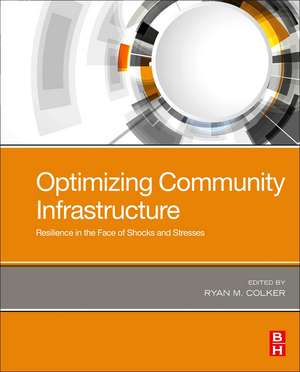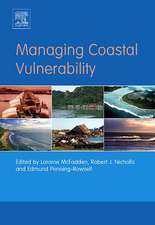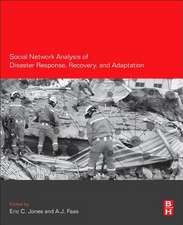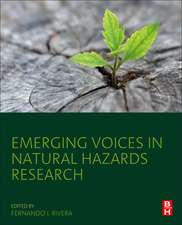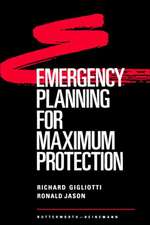Optimizing Community Infrastructure: Resilience in the Face of Shocks and Stresses
Editat de Ryan Colkeren Limba Engleză Paperback – 11 oct 2019
- Provides updated information on resilience, especially on infrastructure, finance, land use, standards and policies
- Includes case studies that illustrate how communities have increased their resilience to natural and other disasters
- Analyzes the institutional, political, social and economic dimensions of resilience at the community level
- Illustrates the interdependencies and interconnectedness of infrastructure systems and how community resilience relies on a holistic approach
- Examines responses to emerging risks associated with climate change
Preț: 597.42 lei
Preț vechi: 765.03 lei
-22% Nou
Puncte Express: 896
Preț estimativ în valută:
114.32€ • 122.24$ • 95.31£
114.32€ • 122.24$ • 95.31£
Carte tipărită la comandă
Livrare economică 10-24 aprilie
Preluare comenzi: 021 569.72.76
Specificații
ISBN-13: 9780128162408
ISBN-10: 0128162406
Pagini: 310
Dimensiuni: 191 x 235 x 18 mm
Greutate: 0.54 kg
Editura: ELSEVIER SCIENCE
ISBN-10: 0128162406
Pagini: 310
Dimensiuni: 191 x 235 x 18 mm
Greutate: 0.54 kg
Editura: ELSEVIER SCIENCE
Public țintă
Professionals in the fields of land planning, engineering, architecture, urban planning, energy planning, water management, insurance, disaster prevention (e.g. civil protection), emergency management, corporate social responsibility, policy development, and climate risk communication. Also suitable for use in academic settings focused on resilience or interdisciplinary policy.Cuprins
Introduction to Infrastructure Resilience
Part I: Making the Case
Introduction
1. Resilient Infrastructure: Understanding Interconnectedness and Long-Term Risk
Alice C. Hill and William Kakenmaster
2. Sustainable and Resilient Buildings: Essential Together
Jason Hartke
Resilience Solutions
Part II: Utilities
Introduction
3. Managing Risk to Critical Infrastructures, Their Interdependencies, and the Region They Serve: A Risk Management Process
Jerry P. Brashear
4. Resilience of Electric Power Infrastructure
Jeff Dagle
5. Becoming a Resilient Water System: A Transformative Process
Michael Hooker, Geoffrey G. Miller and Timothy Taber
Part III: Finance
Introduction
6. Financing Resilient Infrastructure
Joyce Coffee
7. Addressing Climate Risk in Financial Decision Making
Natalie Ambrosio, Yoon Hui Kim, Stacy Swann and Ziyue Wang
Part VI: Landscapes and Land Use
Introduction
8. Harnessing Green Infrastructure for Resilient, Natural Solutions
Charriss R.H. York and John Jacob
9. How Smart Land Use Policies Help Avoid Future Headaches
Samantha Medlock and James Schwab
Part V: Buildings
Introduction
10. The New Resilient Built Environment: Perspectives from Investors and Owners of Private Buildings
Devesh Nirmul and John Scott
11. The Role of the Designers and Other Building Practitioners in Advancing Resilience
Allison Hoadley Anderson
12. Building Codes: The Foundation for Resilient Communities
Cindy Davis and James Tim Ryan
Part VI: Policies & Practices
Introduction
13. Designing for Resilient Systems Under Emerging Risks
Allison C. Reilly and Bilal Ayyub
14. Where Are We? Why Community-Wide Benchmarking is Important
M. John Plodinec
15. How Philanthropy is Transforming Resilience Theory into Practical Applications at the Local Level
Robert G. Ottenhoff
Part VII: Conclusion
16. A Vision for Resilient Infrastructure
Ryan M. Colker
Part I: Making the Case
Introduction
1. Resilient Infrastructure: Understanding Interconnectedness and Long-Term Risk
Alice C. Hill and William Kakenmaster
2. Sustainable and Resilient Buildings: Essential Together
Jason Hartke
Resilience Solutions
Part II: Utilities
Introduction
3. Managing Risk to Critical Infrastructures, Their Interdependencies, and the Region They Serve: A Risk Management Process
Jerry P. Brashear
4. Resilience of Electric Power Infrastructure
Jeff Dagle
5. Becoming a Resilient Water System: A Transformative Process
Michael Hooker, Geoffrey G. Miller and Timothy Taber
Part III: Finance
Introduction
6. Financing Resilient Infrastructure
Joyce Coffee
7. Addressing Climate Risk in Financial Decision Making
Natalie Ambrosio, Yoon Hui Kim, Stacy Swann and Ziyue Wang
Part VI: Landscapes and Land Use
Introduction
8. Harnessing Green Infrastructure for Resilient, Natural Solutions
Charriss R.H. York and John Jacob
9. How Smart Land Use Policies Help Avoid Future Headaches
Samantha Medlock and James Schwab
Part V: Buildings
Introduction
10. The New Resilient Built Environment: Perspectives from Investors and Owners of Private Buildings
Devesh Nirmul and John Scott
11. The Role of the Designers and Other Building Practitioners in Advancing Resilience
Allison Hoadley Anderson
12. Building Codes: The Foundation for Resilient Communities
Cindy Davis and James Tim Ryan
Part VI: Policies & Practices
Introduction
13. Designing for Resilient Systems Under Emerging Risks
Allison C. Reilly and Bilal Ayyub
14. Where Are We? Why Community-Wide Benchmarking is Important
M. John Plodinec
15. How Philanthropy is Transforming Resilience Theory into Practical Applications at the Local Level
Robert G. Ottenhoff
Part VII: Conclusion
16. A Vision for Resilient Infrastructure
Ryan M. Colker
